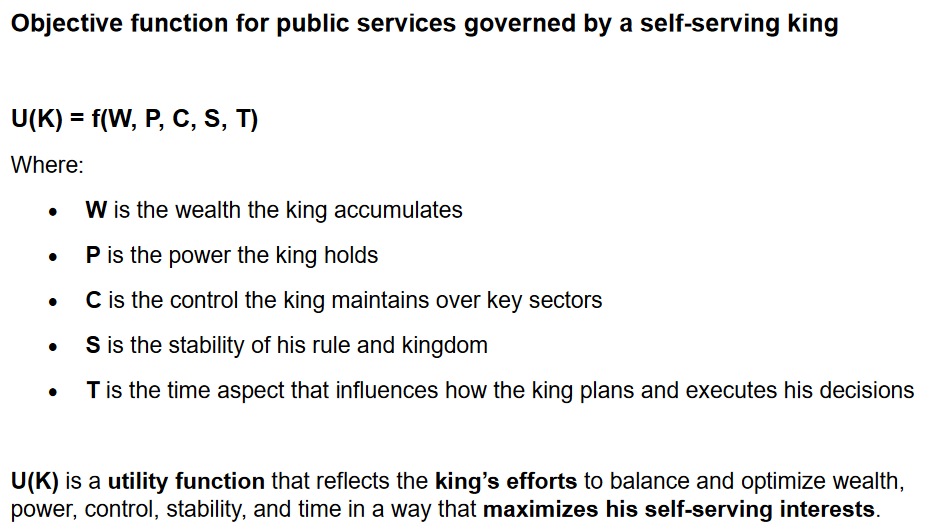Objective function for public services governed by a self-serving king aka dictator

Maximize U(K) = f(W, P, C, S, T)
U(K) represents the utility or overall objective of the king (denoted as K). This utility is a function of various factors that contribute to the king's goals and desires, such as wealth, power, control, stability, and time.
1. Wealth (W): represents the king's wealth. Maximizing wealth would typically be one of the king’s primary goals, as it directly enhances his power and ability to control resources, including both public and private sectors. Wealth could come from taxes, control over resources, or exploiting public services for personal gain.
2. Power (P): denotes the king's power or authority. Power could refer to the king's influence over the population, the military, or other political entities. Maximizing power involves maintaining control over the kingdom, ensuring loyalty from subjects, and securing the throne from potential challengers. This could also include control over important institutions like the military, judicial system, or elite factions.
3. Control (C): refers to the king’s control over key institutions or sectors within the kingdom. In the context of public services, this could mean the king’s ability to influence or manage sectors like education, healthcare, infrastructure, and security. Control allows the king to use these services strategically to maintain power, wealth, and public support, as well as to minimize risks or challenges to his reign.
4. Stability (S): represents the stability of the king's rule and the kingdom in general. A stable kingdom reduces the risk of rebellion, civil unrest, or foreign threats. Stability is often closely linked to the satisfaction of the general population, although in a self-serving monarchy, this might be achieved through manipulation, propaganda, or strategic concessions, rather than genuine welfare investments. The king will want to maintain a stable society to ensure that his rule is unchallenged.
5. Time (T): refers to the time factor, which could represent the temporal aspect of governance. The king might need to consider how the decisions made today affect long-term outcomes for his wealth, power, and control. Time could also influence how the king balances immediate gains with the long-term sustainability of his rule. A self-serving king may focus on maximizing short-term benefits, but still needs to consider the risks of undermining long-term stability.
Example Interpretation:
In this case, the king might try to maximize his utility by:
- Increasing W through resource extraction, taxation, or controlling profitable industries.
- Maximizing P through strategic alliances, military power, or public loyalty.
- Strengthening C by maintaining control over public services like education and healthcare, using them to solidify his power.
- Ensuring S by avoiding uprisings or unrest, possibly by pacifying the population with superficial reforms.
- Managing T by balancing short-term power grabs with long-term sustainability, taking into account how decisions today may affect his rule in the future.
Conclusion:
In essence, U(K) is a utility function that reflects thCe king’s efforts to balance and optimize wealth, power, control, stability, and time in a way that maximizes his self-serving interests.
Content generated by OpenAI's ChatGPT.
Should public services like education & healthcare, etc. be aligned with a king’s goals or citizens’ needs ?

